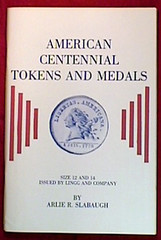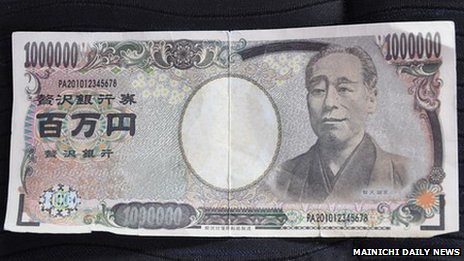
About UsThe Numismatic Bibliomania Society is a non-profit organization promoting numismatic literature. For more information please see our web site at coinbooks.org SubscriptionsThose wishing to become new E-Sylum subscribers (or wishing to Unsubscribe) can go to the following web page link MembershipThere is a membership application available on the web site Membership Application To join, print the application and return it with your check to the address printed on the application. Membership is only $15 to addresses in the U.S., $20 for First Class mail, and $25 elsewhere. For those without web access, write to: David M. Sundman, Treasurer AsylumFor Asylum mailing address changes and other membership questions, contact David at this email address: dsundman@LittletonCoin.com SubmissionsTo submit items for publication in The E-Sylum, just Reply to this message, or write to the Editor at this address: whomren@gmail.com
BUY THE BOOK BEFORE THE COIN |
- WAYNE'S WORDS: THE E-SYLUM NOVEMBER 24, 2013
- NBS DUES TO RISE IN 2014
- NEW BOOK: AUTHORITATIVE REFERENCE ON LIBERTY SEATED DOLLARS
- NEW BOOKS IN THE MONETA SERIES: #161-#166
- NEW JOURNAL: ROMAN DENARII FINDS IN SWEDEN
- GAR TRAVIS 1959-2013
- BOOK REVIEW: CIVIL WAR STAMP ENVELOPES
- BOOK REVIEW: JOHN J. FORD AND THE FRANKLIN HOARD
- HERITAGE MAGAZINE B. MAX MEHL ARTICLE
- EUROPEAN COINAGE 1500–1600 REFERENCE CATALOGS
- NOTES FROM E-SYLUM READERS: NOVEMBER 24, 2013
- THE WORLDWIDE BI-METALLIC COLLECTORS CLUB
- NATIONAL BANK NOTE OF CENTRAL CITY, COLORADO TERRITORY
- MORE ON A CABINET OF CENTENNIAL MEDALS
- ANA SEEKS ARTICLES FOR THE NUMISMATIST
- US SUBSISTENCE DEPARMENT TOKENS INFORMATION SOUGHT
- ERIC NEWMAN COLLECTION SALE II COVERAGE
- CONGRESSIONAL GOLD MEDALS FOR NATIVE AMERICAN CODE TALKERS
- ANA MUSEUM RECEIVES DONATION OF GERRY HANSEN COINS
- STANLEY GIBBONS GROUP ACQUIRES NOBLE INVESTMENTS
- HARVEY STACK ON THE MILTON HOLMES COLLECTION
- CUHAJ ATTENDS XII INTERNATIONAL SYMPOSIUM OF MEDALS
- BRINKS CHARGED WITH PENNY SWITCHEROO
- METAL DETECTORIST UNCOVERS RARE GOLD COIN OF EMPEROR LICINIUS I
- 1881 NETHERLANDS GOLD LIFESAVING MEDAL
- THE PRAGER WINERY MONEY ROOM
- FAKE MILLION YEN BANKNOTE FOOLS CLERKS IN JAPAN
- ANOTHER GOLD BARS IN AIRPLANE TOILET STORY
- FEATURED WEB SITE: COINING TECHNOLOGY HERITAGE PROJECT
Click here to access the complete archive
To comment or submit articles, reply to whomren@gmail.com
WAYNE'S WORDS: THE E-SYLUM NOVEMBER 24, 2013

We have no new subscribers this week. We have 1,680 email subscribers, plus 255 followers on Facebook.
This week we open with a note on NBS membership dues, eight new books and journals, and two reviews. Other topics include European coinage reference catalogs, part II of the Newman sales, code talkers Congressional gold medals, the Milton Holmes collection and coining technology over the centuries.
To learn more about numismatic employment opportunities, Roman Denarii found in Sweden, the life of Gar Travis, Moulton's book on John J. Ford, Jr. and the ‘Franklin Hoard’, collectors Waldo Newcomer and James Ten Eyck, the Goloid Metric Dollar, U.S. Subsistence Department tokens, and the Ho-Chunk Nation, read on. Have a great week, everyone!
Wayne Homren
Editor, The E-Sylum
NBS DUES TO RISE IN 2014
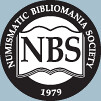 While The E-Sylum is free to all, only paid members of the Numismatic Bibliomania Society receive our print journal, The Asylum. Treasurer David Sundman has announced the NBS Board of Governors' decision to increase membership dues in 2014.
-Editor
While The E-Sylum is free to all, only paid members of the Numismatic Bibliomania Society receive our print journal, The Asylum. Treasurer David Sundman has announced the NBS Board of Governors' decision to increase membership dues in 2014.
-Editor

Membership in the Numismatic Bibliomania Society includes a subscription to our journal, The Asylum. New members receive a valuable back issue of The Asylum – a collectible in its own right – and all new issues upon publication.
Treasurer Sundman adds:
E-Sylum readers who are not members can join the NBS, and current members can extend their membership at the old 2013 rates before the new 2014 dues rates go into effect. For a membership application, see: www.coinbooks.org/about/membership.html
For more information on the NBS, see: www.coinbooks.org
NEW BOOK: AUTHORITATIVE REFERENCE ON LIBERTY SEATED DOLLARS
The Authoritative Reference on Liberty Seated Dollars book by Kevin Flynn should be going to print around Xmas. The plan is to only print the number of books that are ordered prepublication. If only 30 books are ordered prepublication, then only 30 books plus those books for individuals who helped will be printed. The book is 8 ½ by 11, 175 pages. Softcover $39.95.
The primary purpose of this book was to create a complete and comprehensive reference for the Liberty Seated Dollars series including all die varieties, history, collecting, historical documents, and hot topic such as the 1851 and 1852 proof restrikes, 1866 No Motto Dollars, rare date and mint marks such as the 1870-S Dollar, and early proof mintages.
The die variety section of the book includes 10 doubled dies, 7 misplaced dates, and 14 repunched date. Several more die varieties should be added by the time the book is published. For each die variety listed, detailed macro photos make identification much easier. Most of the varieties include multiple photographs showing different details. Included also for each variety is a detailed description of the variety, diagnostics, including die markers such as die cracks, scratches, clashes which can make identifying the variety easier, pricing, and cross references.
Many new archive letters were uncovered relative to the Liberty Seated series and are included. This greatly helped in the analysis of the history section and shed new details on the Liberty Seated series, especially for why the designs were chosen, changed and why it was terminated. Also included are archive letters regarding the hot topics which help add clarity.
The date-by-date section offers an analysis of each date including scarcity, striking characteristics, world history which occurred that year, hot topics, comments, current values, prices realized from Heritage Auctions, and the certified population counts from PCGS and NGC.
The Hot Topics section contains a several detailed studies on the Liberty Seated Dollars series including an analysis of: The 1851 and 1852 Dollar proof restrikes, understand why these were struck in later years and who had them struck; The 1866 No Motto Dollar, learn the history of these and when they were struck; Early proof counts, a complete analysis of the Liberty Seated proof struck before 1858, before official counts were kept; A complete analysis Liberty Seated proof counts, how several of the currently accepted proof counts are incorrect, see the correct counts.
The current plan is to only print the number of copies ordered prepublication. There is no current plans to offer these after they are printed. Retail for the softcover is $39.95. To order, send a check or money order to Kevin Flynn, P.O. Box 396, Lumberton, NJ 08048. Please include $5 for media shipping or $10 for first class shipping. See other books available at www.kevinjflynn.com .
NEW BOOKS IN THE MONETA SERIES: #161-#166
In the series Trouvailles et tresors monetaires en Belgique (J.-L. Dengis)
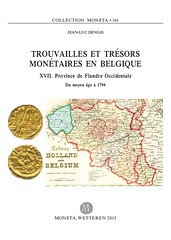 Moneta # 161, XVII. Province de Flandre Occidentale (Du moyen âge à 1794), 150 p.
Moneta # 161, XVII. Province de Flandre Occidentale (Du moyen âge à 1794), 150 p.
www.moneta.be/volumes/moneta_161.htm
Moneta # 162, XVIII. Province de Flandre Orientale (Du moyen âge à 1794), 200 p.
www.moneta.be/volumes/moneta_162.htm
In the series Documents and Studies on 19th c. Monetary History
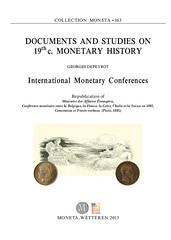 Moneta # 163, International Monetary Conferences, Republication of Ministère des Affaires Étrangères,
Conférence monétaire entre la Belgique, la France, la Grèce, l'Italie et la Suisse en 1885, Convention et Procès-verbaux (Paris, 1885), VI+324+4* p.
Moneta # 163, International Monetary Conferences, Republication of Ministère des Affaires Étrangères,
Conférence monétaire entre la Belgique, la France, la Grèce, l'Italie et la Suisse en 1885, Convention et Procès-verbaux (Paris, 1885), VI+324+4* p.
www.moneta.be/volumes/moneta_163.htm
Moneta # 164, International Monetary Conferences, Republication of Republication of
Conférence monétaire internationale, Procès-verbaux (Bruxelles, 1892), X+440+4* p.
www.moneta.be/volumes/moneta_164.htm
Moneta # 165, International Monetary Conferences, Republication of International Monetary Conference, Brussels, 1892, Instructions to the Delegates of Great Britain and their report together with the Proceedings of the Conference (London, 1893), X+236+4* p.
www.moneta.be/volumes/moneta_165.htm
Moneta # 166, International Monetary Conferences, Republication of Conférence monétaire entre la Belgique, la France, la Grèce l'Italie et la Suisse en 1893, Arrangement et procès-verbaux (Paris, 1894), VI+148+4* p.
www.moneta.be/volumes/moneta_166.htm
Moneta (Wetteren, Belgium) publishes volumes on numismatics, monetary history, coin finds, from Antiquity to present times, in various languages. Catalogue on www.moneta.be.
The series Documents and Studies on 19th c. Monetary History is linked to the DAMIN program on Silver monetary depreciation and international relations www.anr-damin.net
NEW JOURNAL: ROMAN DENARII FINDS IN SWEDEN
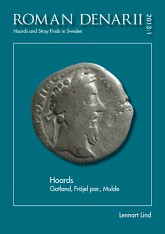 Periodical Roman Denarii
Periodical Roman Denarii
Hoards and Stray Finds in Sweden
Roman denarii, mainly struck during the first two centuries A.D., are the earliest coins which were imported to Sweden. Contemporary Roman gold and bronze coins were also imported, but very few finds are known.
The aim of this new series is to publish the Roman denarii found in Sweden. Each issue will cover one or more hoards or stray finds.
To read the complete article, see: Periodical Roman Denarii (www.archaeology.su.se/english/stockholm-numismatic-institute/publications-nfg/periodical-roman-denarii)
MONOGRAPH SALE - LAST CHANCE!
 As 2013 comes to an end, so does the 100th anniversary of the Buffalo nickel. It is appropriate then, to close-out my monograph dedicated to the one and only 1913 Buffalo nickel struck in copper. I have a limited number of the 2011 monograph “A Forgotten Nickel” available for purchase at a price of $5.00 postpaid. It is the story of the Buffalo Nickels that were housed with the five 1913 Liberty Nickels. Told in collaboration with Mr. Eric P. Newman and illustrated with original photographs by the author. Here is a link to the archived
E-Sylum discussion.
As 2013 comes to an end, so does the 100th anniversary of the Buffalo nickel. It is appropriate then, to close-out my monograph dedicated to the one and only 1913 Buffalo nickel struck in copper. I have a limited number of the 2011 monograph “A Forgotten Nickel” available for purchase at a price of $5.00 postpaid. It is the story of the Buffalo Nickels that were housed with the five 1913 Liberty Nickels. Told in collaboration with Mr. Eric P. Newman and illustrated with original photographs by the author. Here is a link to the archived
E-Sylum discussion.
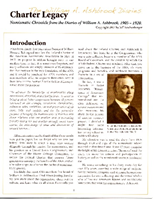 I also have available a small number of my 2007 monograph “Charter Legacy, The William A. Ashbrook Diaries”. This is a chronicle of Ashbrook’s diaries from 1905 to 1920 with an emphasis on the numismatic content and other historic happenings of the period. The price is $5.00 postpaid. Here is a link to the archived
E-Sylum discussion.
I also have available a small number of my 2007 monograph “Charter Legacy, The William A. Ashbrook Diaries”. This is a chronicle of Ashbrook’s diaries from 1905 to 1920 with an emphasis on the numismatic content and other historic happenings of the period. The price is $5.00 postpaid. Here is a link to the archived
E-Sylum discussion.
You can order both items for $9.00 postpaid. Please send an email to reserve a copy: jkreichenberger@hotmail.com First come-first serve, when they’re gone they’re gone.
Jeff Reichenberger
P.O. Box 3572
Oshkosh, WI 54903
GAR TRAVIS 1959-2013
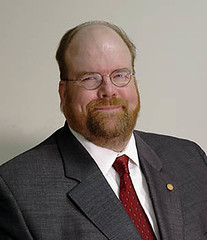 Yesterday, I learned through Pete Smith and Greg Heim that longtime E-Sylum contributor has passed away. For years, whenever I pressed the button to publish an issue of this newsletter, Gar was often among the first readers to respond. I never met him in person, but he was a regular presence here for many years. In June of this year he announced his retirement from his position at Teletrade; he had cancer and his health was deteriorating.
Yesterday, I learned through Pete Smith and Greg Heim that longtime E-Sylum contributor has passed away. For years, whenever I pressed the button to publish an issue of this newsletter, Gar was often among the first readers to respond. I never met him in person, but he was a regular presence here for many years. In June of this year he announced his retirement from his position at Teletrade; he had cancer and his health was deteriorating.
My last communication from him was a week ago Saturday; his submission on the Prince George Christening £5 Coin was published in last Sunday's issue. My email files have dozens and dozens of his notes, covering topics as diverse as Portugalozers, a medal for Muhammad Ali, Spongebob coins, Congressional Gold medals, Fairbanks Alaska bakery tokens and the Bank of England ghost. His presence will be missed, but still felt. -Editor
Brian Kendrella of Stack’s Bowers Galleries (and Teletrade) writes:
I worked with Gar from when I joined the company in late 2009 until his illness forced him to take leave in June of this year. He was a skilled and knowledgeable numismatist, a talented photographer, and a generous friend to many in our company. He will be dearly missed.
Gar once told me he was born and raised in Jacksonville, N.C. The following is from Gar's personal photography web site:
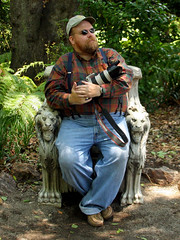 Gar Travis, a 1978 graduate of Fork Union Military Academy and United States Coast Guard Veteran served as a numismatic research consultant for more than fifteen years in North Carolina following his enlistment. He dabbled in film photography; establishing himself as a professional in 1989 and was an early experimentalist in the field of digital numismatic photography.
Gar Travis, a 1978 graduate of Fork Union Military Academy and United States Coast Guard Veteran served as a numismatic research consultant for more than fifteen years in North Carolina following his enlistment. He dabbled in film photography; establishing himself as a professional in 1989 and was an early experimentalist in the field of digital numismatic photography.
Moving to California in 2004 he assumed a position with one of the world's largest numismatic auction houses; Greg Martin Auctions as a senior numismatist and chief cataloger. Gar retired from his numismatic position after serving nine superb years seeing the company grow globally and being recognized as a Fortune 500 Company; which is known today as Stack's-Bowers Galleries.
Wanting to show where he has been and what he has seen to his long time friends in North Carolina and willing to share his visual captures with the world, Gar offers this web site. A "one of a kind" his fellow photographers call him; as he is a philanthropic professional photographer - giving his services in exchange for substantial donations to several youth based non-profits he endorses. Giving his time and talent Gar is the Chief of Photography of Powered Sport Flying magazine, a contributing editor to The NUMISMATIST magazine, Chief Entertainment Photographer for the Renaissance Pleasure Faire® of Southern California, Ship's Photographer for the American Pride and an Adviser to the Children's Maritime Foundation.
Gar is the author of the book; Cyprus Coins, which he also photo-illustrated. The text was published in 2006 by the Cyprus Museum. The book offers a numismatic chronology of Cyprus and features coins housed in the museum.
Greg Heim writes:
I first met Gar at the 1991 ANA Convention at the NLG Bash. Lisa met him three years later at the venue in Detroit.
We kept in touch on and off over the years, but chatted frequently on Facebook over the past three years or so. He was very open and candid about dealing with his brain cancer, and spent his last weeks posting the scrumptious meals that his caregivers were providing him!
Gar worked for Teletrade for many years, but he also developed an excellent reputation as a freelance photographer - especially in the area of Renaissance Fairs. Tons of his work is being reposted on Facebook by his many friends in his memory.
He called me on a Sunday morning about six weeks ago, telling me that the end was getting near. I was honored that he chatted with me and shared this. As I stated in my posts, his candor and refreshing personality were constant throughout the 20 or so years that Lisa and I knew him.
Susie Nulty writes:
Gar excelled at photography but did not just take pictures, he captured friendships. Those friends included his subjects and fellow photographers. Gar and I discussed making a web gallery of the photographs he took of those fellow photographers and I will do that over the next few weeks and think of Gar who suggested calling it, 'Photographers: A Rogues Gallery.' Working on his photography web site has been a privilege and gives one an appreciation of Gar's fine "eye." His generosity should be a guiding example to us all. My heart aches as I will miss working with him and especially his friendship.
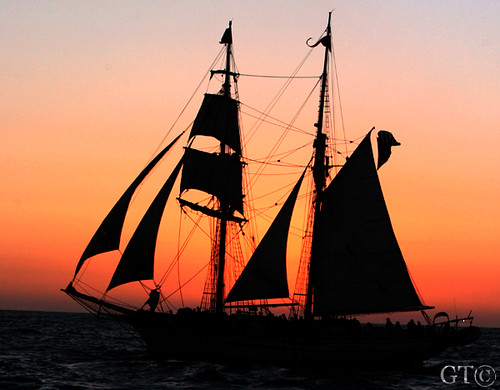
To read the earlier E-Sylum articles, see:
GAR TRAVIS RETIRES FROM TELETRADE
(www.coinbooks.org/esylum_v16n26a12.html)
Digital Photography by Gar Travis
(www.garphoto.com)
NOTES FROM E-SYLUM READERS: NOVEMBER 17, 2013 : The Prince George Christening £5 Coin
(www.coinbooks.org/esylum_v16n47a11.html)
THE BOOK BAZARRE
BOOK REVIEW: CIVIL WAR STAMP ENVELOPES
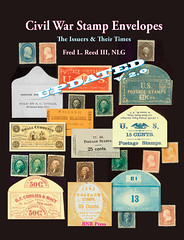 Civil War Stamp Envelopes; Their Issuers and Their Times
Civil War Stamp Envelopes; Their Issuers and Their Times
Author--Fred Reed III
Fred Reed has hit another home run with his new book on Civil War Stamp Envelopes. The topic is one that has a limited collector base due to the relatively small number that still exist today (128 merchants issued 514 different varieties). But Fred has once again, as with his Encased Postage Stamp (EPS) and Lincoln books, gone above the normal item catalog and has completed a historical masterpiece.
As a collector and researcher, I have been concerned that we are losing the history of the notes and other items as the hobby is seemingly becoming more focused on the financial aspect. But what Fred does, in my opinion, better than any other author today, is instill that historical aspect into his books. He did that well in the EPS and the Lincoln books but has surpassed himself with this book. His in-depth research has unearthed a lot of previously unknown and unpublished history of the merchant/printer of each envelope. By reading his book, you almost get the feeling of knowing these people from our past. Before Fred’s book, the only reference available was a piece by Milt Friedberg that only had black & white pictures and due to some collectors' refusal to share information, it was an incomplete list.
The book begins with a foreword by Art Paradis, the foremost collector of these envelopes who has now amassed the largest collection in existence today. He gives a nice history into his collection and his pursuit of new items. He makes a very poignant statement: “I want to know the range of what is available and background information about the companies and people associated with them. This book fulfills these needs and desires beyond all expectations.”
Reed then progresses into a very detailed introduction to the small change crisis of the time, the different types of mediums that were used and how postage stamps came to be used and the envelopes used to protect them. A timeline follows that is very detailed and starts with the first appearance of the envelopes on July 4, 1862 and then goes into other appearances, major sales and concludes with the release of the book in October, 2013.
And then he goes into a lengthy history of prior cataloging efforts and famous collections/collectors. Having known Milt Friedberg for years and considering him my mentor, I know he was frustrated with the information he was able to gather on this subject. I know he would be proud to be mentioned in the book and with Fred’s efforts to detail the history of these little gems. This is one of the best parts of the book and is essentially a history of collecting postage stamp envelopes.
Fred then goes into the meat of the book, the discussion of the different merchants. He has gone to great lengths to detail with illustrations when possible of the different envelopes and provides a description, printer and other information. He begins each listing with a history of the envelope as to who has owned it, prices it has brought in past sales and today's location if known.
Some will say the book needs to have valuations in it. I totally disagree as the value of these items are not static but are determined on a “day of sale” basis due to limited supply and demand. Fred does a nice job of including the pertinent sales information, especially the values the envelopes have achieved recently. Then Fred includes the historical information, from pictures of the merchants, the buildings, newspaper ads, etc. Fred even includes historical information on some envelopes that are known to have been printed but are not known location-wise today as well as those firmly ensconced in the Smithsonian Collection.
After detailing these 128 merchants, Fred lists and shows pictures of a number of envelopes that have no merchant name on them and therefore cannot be researched.
Fred concludes the book with two good references. First is a synopsis of the envelopes by Reed number with Milton Number when known, the issuer name and their business or trade and ends with an extensive bibliography that will provide future historians much to review.
It was exciting to read Fred’s latest book. It gives a new perspective to these envelopes and provides so much new information it is almost unfathomable. It was a pleasure to be able to contribute in a very small way to the book. If you are a collector of Postage Stamp Envelopes, fractional currency, encased postage or a history buff, I highly recommend this book to you.
For ordering information, see: NEW BOOK: CIVIL WAR STAMP ENVELOPES, 2ND PRINTING (www.coinbooks.org/esylum_v16n47a04.html)
BOOK REVIEW: JOHN J. FORD AND THE FRANKLIN HOARD
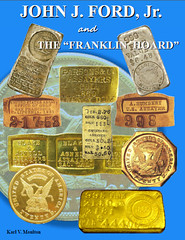 Much has already been written (see links below) about Karl Moulton's new book, John J. Ford, Jr. and the ‘Franklin Hoard’ .
I'll try not to rehash those discussions, and instead focus on some other aspects of the book.
Much has already been written (see links below) about Karl Moulton's new book, John J. Ford, Jr. and the ‘Franklin Hoard’ .
I'll try not to rehash those discussions, and instead focus on some other aspects of the book.
One thing I will reiterate though, is that this is quite a hefty tome, perhaps three volumes worth of material within one set of glossy covers. Don't consider the book's price alone ($250), but be aware of what you're getting for your money. The 903-page hardbound is printed on glossy paper and is chock full of full-color photographs of documents, coins, gold and silver bars, people, and more. For the bibliophile, it's a treat - also pictured are quite a number of numismatic books, catalogs and periodical articles which address the subjects at hand.
At the recent Baltimore show I sat next to David Lange at dinner one night, and we talked about the book. He and I were in such agreement that I asked him to contribute to this review. He writes:
I have no particular interest in the commercially issued coins and ingots of the Old West beyond what I need to know when attributing submissions to NGC, but then Karl Moulton's new book is not a catalog in the vein of Don Kagin's 1981 reference work. The primary virtue of Karl's book is its behind-the-scenes look at that segment of the coin market during the 1950s-70s. I found his account of the lives of John J. Ford Jr. and Gerow Paul Franklin to be immensely entertaining as both history and great gossip.
JJF in particular was one of a kind, and for that most of us should be grateful. My one and only interaction with him came around the time of the Great Debate of 1999 when he was seeking numismatists of the current generation who had not been prejudiced by earlier episodes and might support his assertion that the prooflike USAO twenties were genuine products of the period. I had not yet seen one, but I'd seen plenty of genuine California pioneer pieces. He showed me an example of one of the coins in question, and I immediately blurted out that it just didn't look like 19th Century surfaces. I don't recall his exact words at that point, but they certainly did not include an invitation to join him for lunch.
The reproduction of so many vintage letters, invoices, etc. in Karl's book gives one a good understanding of the players, both Ford and Franklin, as well as their customers and their sometimes shadowy associates. While the book has a certain scrapbook feel to it, Karl's running interpretation of these documents is both insightful and well written.
It takes a leap of faith to plunk down the rather high price of this book, but then it is a whopping 900+ pages and a high quality product. Anyone who loves the history of our hobby as much as I do will not think twice about making this investment, but the cost may limit its sales overall. Those persons still on the fence about acquiring Karl's book should remember, however, the old axiom that when an expensive book is out of print it can't be bought at any price...
Getting back to numismatic literature for a moment, the author notes in his Preface that
"Generally speaking, what Ford presented over the years was accepted as fact, and copied in auction catalogues that offered items he had originally marketed or owned. Ford's background information can also be found in reference books where the writer had checked with Ford, since he was apparently the only one who knew the background story about such items."
Early in the book several such references are pictured, including Don Kagin's 1981 Private Gold Coins and Patterns of the United States and the 1982 Bowers and Ruddy Henry H. Clifford collection sale.
Rightfully, the author notes in his Preface that
"It needs to be pointed out that in modern numismatic literature references there was no intent by the writers to perpetrate a fraud. They apparently did not know, or suspect, that some of the items they were describing were modern fakes. What is presented now was, for the most part, not common knowledge at the time; therefore, they should not be accused of intentional wrongdoing."
Moulton started with the numismatic basics, going far back in the known literature to review the earliest known documented bars and ingots. For example, two Moffat & Co. bars were described in the U.S. Mint collection in 1849 and 1851 by Eckfeldt and DuBois.
The book covers a tremendous array of issues, artifacts, people and events, from the first North Carolina gold find in 1799, to the 1849 gold rush and money circulating in San Francisco in 1855, to the 1909 Zabriske sale Augustus Humbert items, Roosevelt's 1933 gold order, the first appearances of the questionable gold bars in the 1950s, Buttrey's 1972 research, and the 1999 "Great Debate" between Buttrey and Michael Hodder, at which I was present.
As for my back-of-the-book test, the bibliography spans eleven full pages, and the index seven (The E-Sylum gets twenty-seven listings!) There are footnotes throughout, but no extensive end notes. However, the book's all-inclusive methodology makes these less necessary; while some have called Moulton's a "scrapbook" approach, to me it's a fabulous collection of original source material, with page after page of correspondence and documents reproduced in full - a researcher's paradise.
I knew John Ford. Or rather, I should say I met him on multiple occasions, sometimes spending time at length, and had several other interactions by telephone and mail. I can attest to the characteristics generally ascribed to him. He had a wide and deep numismatic library and was extremely well read on U.S. numismatic history. He knew his subjects deep and cold. Yet he had the insufferable form of brilliance that holds contempt for those less brilliant than he (perhaps your Editor included, for all I know). A fastidious penny-pincher, he could be equally insufferable even among friends. Yet he was a fascinating conversationalist, a raconteur who could hold court for hours on his favorite subjects.
What Moulton has written is far more than a story of the disputed "Franklin Hoard". He's assembled a mass of material shedding light on the enigmatic John J. Ford, an undisputedly key figure in American numismatics. While not a biography, it covers many key events in Ford's life and career. Even without the voluminous material relating to the "Franklin Hoard" pieces, the book is valuable for students of American numismatics, for all the reasons David Lange outlined and many more. I recommend it to everyone, particularly bibliophiles and other students of the hobby. It's a fascinating read.
Copies of the John J. Ford, Jr., and the 'Franklin Hoard' book can be ordered at the price of $250.00, by sending payment to:
Karl Moulton
PO Box 1073
Congress, AZ, 85332
Questions can be directed to Karl at: numiscats@aol.com
To read the earlier E-Sylum articles, see:
NEW BOOK: JOHN J. FORD, JR., AND THE FRANKLIN HOARD
(www.coinbooks.org/esylum_v15n53a04.html)
BOOK REVIEW: JOHN J. FORD AND THE FRANKLIN HOARD (Kleeberg)
(www.coinbooks.org/esylum_v16n26a07.html)
HARVEY STACK ON FORD, FRANKLIN, AND FALSE GOLD
(www.coinbooks.org/esylum_v16n27a11.html)
BOOK REVIEW: JOHN J. FORD AND THE FRANKLIN HOARD (Weinberg)
(www.coinbooks.org/esylum_v16n28a06.html)
HERITAGE MAGAZINE B. MAX MEHL ARTICLE
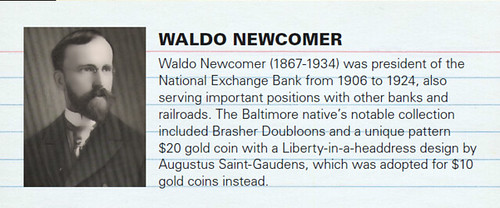
I received the latest Heritage Magazine for subscribers and Legacy Club members. Within it is a multi-page article with various correspondence to B. Max Mehl from prominent Mehl auction/private treaty consignors. But what is unusual about the lengthy article are the numerous rare pictures of the famous numismatists, many or most of whom I've not seen images of before.
Good close-up bust images of James Ten Eyck, Waldo Newcomer, William A Philpott, William Atwater, King Farouk and of course Mehl himself, together with their oft-fancy letterheads. Of course Atwater, Newcomer and Ten Eyck are legendary and, I believe, images are quite rare.
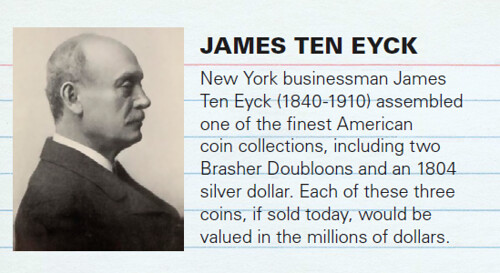
To access the magazine (registration required), see:
Numismatic Missives
(http://www.intelligentcollector.com/mag/2013-11/)
or
www.intelligentcollector.com/mag/2013-11/offline/download.pdf

EUROPEAN COINAGE 1500–1600 REFERENCE CATALOGS
Ken Bressett writes:
Another nice edition of The E-Sylum to start my week. Thanks for all your dedicated work. It is very much appreciated. Regarding the 1594 coin in question. It is from Poland and is a three groschen silver piece of King Sigismund III who ruled 1587-1632. Good general references on coins from 1500-1600 are probably scarcer than the coins.
Jim Duncan of New Zealand writes:
European coinage? Try Saurma - in full "Die Saurmasche Munzsammlung". Goes up to 1620. Almost all pix, easy to follow.
Dave Hirt writes:
Information on the dollar size coins is easy: Davenport, or several books on World Dollars. But on the minor coins, not so easy. You probably need a special book on the country of the coin.
David Powell writes:
Seth's piece is a Polish trojak, or three groschen, of Sigismund III of Poland. The mark at the bottom, flanked by the date, indicates that it comes from the Lithuanian mint. 16th and early 17th cent Polish small silver is an interesting series, with plenty of minor varieties and often quite moderately priced.
Regarding books on European coinage pre-1600, two general rules:
- You will probably need a separate book, or two, for each country you are interested in.
- Don't expect little luxuries like the books being in English. They may be occasionally, but not often.
One of the challenges of European pieces of this date is finding just what books are out there to go with them. If they are highly pictorial and not text-heavy, their not being in English is not always too great a problem. Pictures and numbers are the same in most Western languages, and if accompanied by plenty of one-line descriptions you will probably pick up some relevant vocabulary as well, by process of deduction and/or elimination.
A few recommendations for various countries, based on my own bookshelf:
Poland: "Monety Dawnej Polski" by Ignacy Zagorski {Warsaw, 1969}. Modest paperback catalogue with very little text, but over 800 superb line drawings. Period covered 1506 to the 1790s; ideal for exploring the varieties and the different mints. Picked mine up for £10, c.1990; excellent value.
"Pieniadz na Ziemiach Polskich, X-XX w." , by Jósef Andrzej Szwagrzyk, pub.1973 - heavier going, more text, but plenty of tables and listings; quality of photography rather moderate; covers 10th to 20th cents.
France: "Les Monnaies Françaises Royales" by Jean Duplessy, in two volumes, pub.1989. Plentiful photographs and line drawings; Vol.1 covers 987-1515, Vol.2 covers 1515-1793.
For provincial issues use E.Boudeau's "Monnaies Françaises Provinciales"; an older style catalogue with a number of line drawings, but not nearly as many.
Portugal: "Livro das Moedas de Portugal", by J.Ferraro Vaz and Javier Salgado. Price catalogue; line drawings of virtually everything. Date range 1128 to late 20th cent.
Spain: "Numismatica Espaňola, 1474 a 1988", by Ferrán Calico, Xavier Calico & Joaquin Trigo {Barcelona, 1988}. Priced catalogue; high-quality paper and superbly illustrated, like many Spanish books.
"Las Monedas Espaňolas, del tremis al euro", by Clemente Adolfo & Juan Cayon; i.e. from the tremessis to the euro, covering the period 411 to 1998. Again, priced catalogue, high quality production and superb illustrations.
Sweden: "Sveriges Mynt, 1521-1977", i.e. The Coinage of Sweden, by Ahlstrom, Almer & Hemmingsson {1970s}. Price catalogue, good photography, good paper, some of the text bilingual Swedish & English.
"Sveriges Besittningsmynt", i.e. Coins of the Swedish Possessions, by Ahlstrom, Almer & Jonsson {1970s}. Colonial supplement to the previous volume. Same series as last, similar style, except trilingual Swedish, German & English.
Norway: "Norges Mynter" by Ahlstrom, Brekke & Hemmingsson {1970s}. Covers from Viking times. Same series as the Swedish books above, style & production almost identical; again partly bilingual.
Denmark: "Danmarks og Norges Monter, 1541-1977" by Holger Hede {1978}. Good photography; no prices, but rarities given, plus extensive listing of varieties.
I suspect that some of the above may have been updated, possibly in some cases by different authors, since I purchased my own copies twenty years or so ago; in certain cases I expect that they are the standard price catalogues for their respective series, and hence liable to reissue quite regularly.
James Higby was the first to respond. He writes:
It's a 3 groschen from Poland, probably Danzig, and is catalogued as #1335 in Handbuch der Polonischen Numismatik by Marian Gumowski. Graz: Akademische Druck, U. Verlagsanstalt, 1960.
Michael Luck and Larry Dziubek agree. Larry writes:
The 1594 coin in question is a Sigismund 3rd / three groschen of Poland. It could well be Gumowski catalog # 1335.
Tony Tumonis of Tucson, Arizona agrees:
The coin in the photograph is a 1594 Lithuania / Poland 3 Groschen issued during the reign of Sigismund III. It is listed as catalog number 1335 in Handbuch Der Polnischen Numismatik by Marion Gumowski.
Erik J. van Loon from the Netherlands found one online. He writes:
If you put the text of one side of a coin into Google (I put the "III GROS ARG TRIP.M.DI. 1594") you will find answers. This was my second hit.
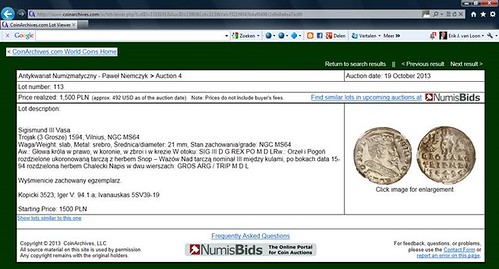
Eric Vanhove writes:
The coin is a 3 groats of Sigismund Vasa. I did a Google search on the reverse and came up with this link: www.icoins.eu/ygimantas-vaza-1588-1632/three-groats/1594.html
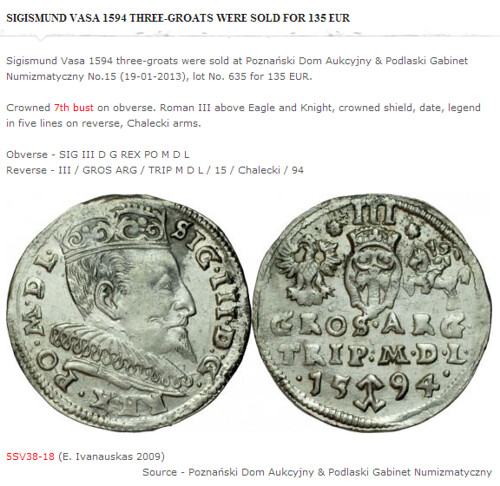
Eric Schena also found examples on the coin (on the numisbids.com site). He writes:
Some of these entries contain catalog references, but as far as I know, there's no standard book for pre-1600 catalog - I have always had to resort to specialized texts and auction listings. Heck, some of the post 1600 coins are not covered in the Standard Catalog of World Coins (two come immediately to mind: Russian "wire" coins and Venetian colonial coins).
Dave Hirt writes:
It looked like a Polish coin to me. I have an old book, Monety Dawnej Polski. It is in Latin and Polish, of which I read neither, but through the line drawings I figured out it is a coin of Sigismund III struck for Lithuania. It may be rare because my book lists several dates in the 1590's, but NOT 1594.
To read the earlier E-Sylum article, see: QUERY: EUROPEAN COINAGE 1500–1600 CATALOG SOUGHT (www.coinbooks.org/esylum_v16n47a08.html)
NOTES FROM E-SYLUM READERS: NOVEMBER 24, 2013
King of Siam Set Publication Found Ken Bressett writes:
Regarding David Lange's printing plate for the King of Siam set image - It was used exclusively in The Whitman Numismatic Journal of September 1964, on page 42, in an article entitled “Updating the Fantastic 1804 Dollar”, by Eric Newman. Ah yes, I remember it well.

To read the earlier E-Sylum article, see: KING OF SIAM SET PRINTING PLATE BOOK SOUGHT (www.coinbooks.org/esylum_v16n47a14.html)
Goloid Metric Dollar Information Found Regarding Roger Burdette's question about the Goloid Metric Dollar in S. K. Hartzfeld's, fourth auction sale (March 14, 1879) Dan Hamelberg writes:
The Goloid Metric Dollar in Harzfeld's 4th sale is lot 478. The listing is as follows: "478 GOLOID METRIC DOLLAR. Only 25 in existence. Extremely rare and desirable." It sold for $40.00, which is a considerable sum for March 14, 1879.
Bill Burd's information agrees, and he provides the page number. He writes:
The 1878 Goloid Metric Dollar is listed on page 19, lot # 478. My catalog has prices realized and this shows selling for $40.00.
Dave Hirt provided this information, too. Roger writes:
Please give everyone my thanks for the information. It improves on what I had...Now, if I can find the first 1880-date metric/goloid/stella sale.....
Another Japanese Occupation of Malaya (Singapore) Book Bob Stewart writes:
I have a copy of the Book “The Japanese Occupation of Malaya (Singapore) and its Currency”. I got my copy from Australia. I was lucky as it came with a half dozen notes and a March 1998 envelope to the previous owner from WONG’S COLLECTIONS, who published the book. The book says 2500 copies were in the first printing, not 500 as reported earlier.
To read the earlier E-Sylum article, see: NOTES FROM E-SYLUM READERS: NOVEMBER 17, 2013 : More on Japanese Occupation of Malaya (Singapore) Book (www.coinbooks.org/esylum_v16n47a11.html)
Cheap Holidays on Government Money Regarding the Commonwealth Heads of Government Meeting (CHOGM) in Sri Lanka, Jim Duncan of New Zealand offers this alternate definition:
CHOGM - Cheap Holidays on Government Money
To read the earlier E-Sylum article, see: SRI LANKA ISSUES NEW COMMEMORATIVE 500 RUPEE NOTE (www.coinbooks.org/club_nbs_esylum_v16n47a21.html)
On Pigeon-Fancying Numismatists Steve Rush writes:
Pete Smith, in his comments about collectors John G. Mills and George F. Seavey, asked if being a pigeon fancier and numismatist was common. In the late 1960’s through early 1970’s while a teenager, I pursued both hobbies. I raced homing pigeons and flew Pensom Rollers.
To read the earlier E-Sylum article, see: MORE ON COLLECTOR JOHN G. MILLS (www.coinbooks.org/esylum_v16n47a12.html)
THE WORLDWIDE BI-METALLIC COLLECTORS CLUB
George Cuhaj writes:
There is a bi-metallic club, which has an extensive listing of everything bi-metallic - medals, tokens, real coins and NCLTs. They have an extensive e-catalog, and web presence.
Pabitra Saha writes:
There is an online bimetallic collectors club. It issues a weekly newsletter. Joining is free. Every six months it releases an excel file, which lists all coins and tokens.
Michael Luck writes:
www.wbcc-online.com ---------- this website is all you need.
To access the Worldwide Bi-Metallic Collectors Club site, see: www.wbcc-online.com
Paul Schultz writes:
This is exactly what he was hoping for, I will pass it on. Thanks!!
To read the earlier E-Sylum article, see: NOTES FROM E-SYLUM READERS: NOVEMBER 17, 2013 : Catalog of Current Bi-Metallic Coins Sought (www.coinbooks.org/esylum_v16n47a11.html)
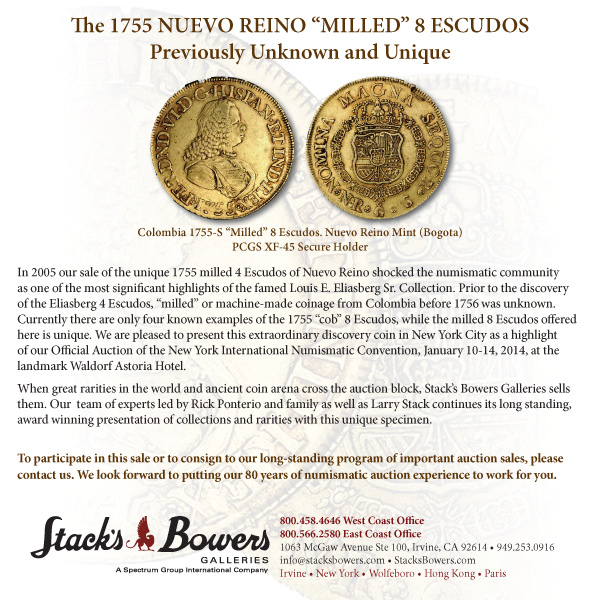
NATIONAL BANK NOTE OF CENTRAL CITY, COLORADO TERRITORY
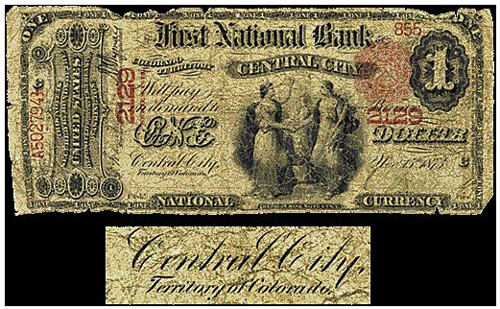
One thing about numismatics is that there is always something new to be discovered.
Our hobby combines coins, tokens, medals and paper money as the basics. If you have enjoyed coins, have you investigated tokens, medals and paper money yet? Coins are a great way to begin, but rare coins can be expensive, as can be common coins in ultra-high grades.
In contrast, in these noncoin series grading is important but is not a prime focus. Prices by comparison are often incredible bargains, grade for grade.
For paper money, for many varieties the finest known example may be only Good or Very Good. And yet, such are in tremendous demand. Ditto for Colonial coins. Just two 1714 Gloucester (Virginia) shillings are known, both of which are well worn and have part of the inscriptions missing. The Guide Book (see page 48) estimates the value as $120,000.
The point of this week’s column is that although high grade is always desirable, thousands of varieties of tokens and currency notes exist only in lower grades — and with many enthusiasts eagerly chasing them.
I illustrate a note I purchased from Tom Denly for $5,500 at the recent Whitman Coins & Collectibles Expo in Baltimore. I suggest that it grades Good 4. It is from the First National Bank of Central City, Colorado Territory, a Wild West rip-roaring gold mining town.
It is the only known federal $1 bill of its type from this bank, a brand new discovery, according to expert Tom Denly (though $1 notes are known from other Colorado Territorial national banks). I am not sure what I will do with it, but I had to buy it as I had never seen or heard of such before.
What do you think?
To read the complete article, see: Always something new (www.coinworld.com/articles/always-something-new)
To read the earlier E-Sylum article, see: WAYNE'S NUMISMATIC DIARY: NOVEMBER 10, 2013 (www.coinbooks.org/esylum_v16n46a19.html)
MORE ON A CABINET OF CENTENNIAL MEDALS
Regarding Ron Abler's new book on Centennial Medals, John Sallay writes:
Publishing your book electronically -- with the capability to edit and amend it over time – is a fantastic evolution in the development of numismatic literature, and I’ll be watching this project closely. Two of my three kids work in the publishing industry (including my older son working on the Kindle at Amazon), so I’m becoming a student of the business. As I think about how to eventually write and publish my own book on school award medals someday, I’ve begun exploring many of the issues you’ve identified, such as how to get feedback and incorporate new information in real time, how to handle the numbering system as new pieces are discovered, and how to make the economics work on a book of extremely narrow but deep interest. I wish you the best of luck, and will be happy to compare notes with you as the project evolves.
I thought I’d send you photos of a medal from my collection, showing a small silver U.S. Mint medal that has been skillfully engraved to be used as a school award. The medal is still in its original case and undoubtedly would have been highly appreciated by the recipient during the big centennial celebration year. I’ve seen only one similar item, on eBay a year or two ago in pretty beat-up condition, so I think it’s a scarce item.
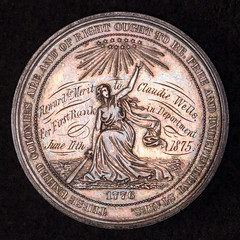
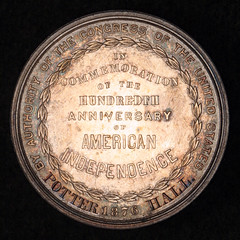
Arlie Slabaugh wrote of the Lingg Company tokens at the Centennial. The book is unavailable anywhere. (We published the book).
Dick Johnson writes:
I am very impressed with Ron Abler's new book. At first I thought it was overkill, but the deeper I get into it I realized the attention (and devotion!) the author has devoted to his chosen subject,
The color illustrations are superb. I like the size -- enlarging small items, reducing large ones -- to one uniform size. The exact size in millimeters is given in the descriptions.
The size in sixteenths (and conversion chart in the appendix) are now considered obsolete. A reader must divide that number by sixteen to come up with inches, and convert the remainder to a number of fourths or eighths or sixteenths. How much better to give diameter dimensions in inches (we Americans think in inches) but numismatists like the accuracy of millimeters (down to a tenth of a millimeter -- as Ron has done in his descriptions). I like to give both in my medal descriptions.
Generally the dimension of the thickness of a medal is less important than its diameter. Thickness is a result of the gauge of sheet metal from which the blanks are cut. In any batch process sheets often vary in thickness, particularly when selected at different times.
In early discussions with Ron I saw he was gathering his catalog data in spreadsheet form. I am pleased he presented his descriptions in straight text. (Spreadsheets have the tendency to discourage the compiler for the empty cells where the data is not available. Checklists are far better. Record what is available.)
I will send Ron some suggestions for his glossary, correcting "Attributes" and "Legend." I'll suggest a definition of "Bronzing" and omitting of "Allotropes of Tin" (no one will seek out that term if they go to "Tin Pest" first.
I'm looking forward to second and subsequent reading of Ron's book. If it was in paper form the pages would soon get dog-eared as I refer to it countless times.
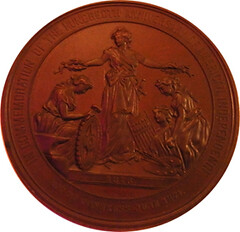 In a correction to last week's Numismatic Diary, the Centennial Medal passed around the table was not Ron's, but Eric Schena's. Sorry! Eric writes:
In a correction to last week's Numismatic Diary, the Centennial Medal passed around the table was not Ron's, but Eric Schena's. Sorry! Eric writes:
I actually got that medal because it was in astonishingly high grade and was beautiful. I have a cased a gilt type I 57 mm medal so this is an excellent companion to that piece. I have to say that Ron's discussion about Centennial medals and his enthusiasm for the subject matter is rather infectious and it certainly shows in his new iBook.
Author Ron Abler writes:
I have received over thirty emails either directly from the E-Sylum article or from A Centennial Cabinet’s Contact page. John Sallay's note was among the first to arrive. So far, readers have been very supportive of the iBook concept, and I’ve already received enough corrections and new information to merit a “second edition” on Monday.
From my perspective, the iBook is working exactly as I had hoped. I’ve asked John for permission to use images of his A40 engraved as an award medal. Mike Packard suggested an interactive Table of Contents that would mirror the printable TOC but allow single-point navigation throughout the entire website. I’ll put that in the third edition. Dave Baldwin pointed out that he has A2720 in brass, and he provided a missing image of the A550 reverse.
Joe Levine has sent me a CD of the Centennial entries from his huge database, curious to find out what I can find to add to the site. William Waychison has given me a wealth of new (to me) information on A2620 and A2580. Jeff Smith has offered several images I do not have, and he thinks he has a medal not in the book (yet). Pete Smith sent an entire page of typos and additional information that I have already inserted into the Centennial Woods drawer. And, I was able to answer a question that Tom Casper had about the identifying characteristics among A1050-1070.
In short, the iBook concept is working. There have been 111 visits to the site from 63 unique visitors, almost all thanks to The E-Sylum and your kind announcement, for which I thank you.
I have added a Users’ Forum to the site, and it will be tested with the second edition. I’m hoping that it will be of service to collectors who want to share ideas and maybe ask questions that I can’t answer. I also have to add a new page that will explain how “editions” (actually, configurations) will allow tracking changes as the iBook matures.
To read the earlier E-Sylum articles, see:
NEW BOOK: A CABINET OF CENTENNIAL MEDALS
(www.coinbooks.org/esylum_v16n47a03.html)
TOM KAYS' NUMISMATIC DIARY: NOVEMBER 17, 2013
(www.coinbooks.org/esylum_v16n47a19.html)
ANA SEEKS ARTICLES FOR THE NUMISMATIST
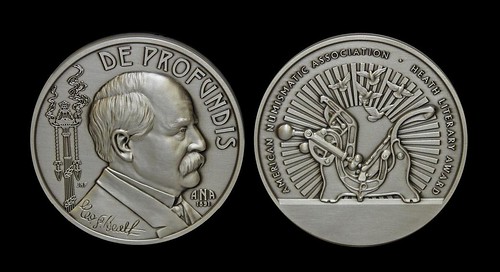
I would like to invite members of the Numismatic Bibliomania Society and the hobby community at large to share their numismatic expertise and know-how by submitting an article to The Numismatist, official publication of the American Numismatic Association.
The mission of the ANA’s award-winning magazine is to educate and provide a forum for the exchange of ideas. It serves as a refreshing review for the experienced collector and as an introduction to essential concepts for hobby newcomers. The staff and contributing editors of The Numismatist welcome the opportunity to review well-written, well-conceived articles displaying original, documented research in the fields of U.S. and world coins and paper money; tokens; medals; scrip; and stock certificates. We also gladly consider reprints from club journals and industry newsletters.
Authors are paid 15 cents per word, with a modest bonus for usable photographs and illustrations. In addition, all feature articles are automatically considered for ANA literary awards, many of which are accompanied by cash prizes ranging from $50 to $400. Heath Literary Award winners also receive a 3-inch nickel-silver or bronze medal, redesigned this year by medallic artist Jamie Franki and generously underwritten by Q. David Bowers. The medal is truly beautiful and presented only to ANA authors.
Thanks to all contributors—past and future—for helping ensure THE NUMISMATIST continues to be the hobby's premier publication. Those who would like to receive author guidelines can contact me at gregory@money.org.
Barbara J. Gregory
Editor-in-Chief
The Numismatist
THE BOOK BAZARRE
US SUBSISTENCE DEPARMENT TOKENS INFORMATION SOUGHT
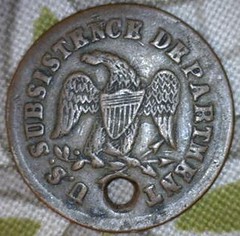
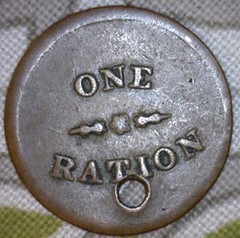
Not long ago I bought a "half a shoe box" of coins from the heirs of a 20 years deceased pawn broker in Georgia. I bought it to have the fun of discovering what the coins, token, etc. were in the box. I found one token that I thought Gramsters might find interesting since there is a "U.S Army" and "Pay" connection.
On the obverse it has the image of a federal eagle and says U.S. SUBSISTENCE DEPARTMENT around the rim. On the reverse it says ONE/RATION with some decorative elements in the center. The token appears to be bronze, has a smooth edge, a medal rotation and a hole in the 6 o'clock position. The diameter of my example measures 24.4mm, about the same as a quarter, but it does show some wear.
I had little idea of what the token was so I turned to the internet. I found a few eBay sales from $40 to $200. All images showed a hole drilled in about the same location. Some of the images showed a few numbers and letters of counterstamps. In an online column "Ask Mark Parker" on the "Western & Eastern Treasures Magazine" website, I found the following:
" During the 1870's, such tokens were reportedly used by Cavalry troops at Fort Larned (a.k.a. Camp Alert) in Kansas and recoveries indicate that they were issued &/or accepted at Indian Wars era posts farther West as well. Some of the tokens were holed or countmarked, perhaps to designate them for use by certain units. These differences do not affect the value, which is generally around $200-$300.
The Subsistence Department (later consolidated with the Pay and Quartermaster's Departments to form the Quartermaster Corps) provided food and other essential supplies. After the Civil War, and prior to the establishment of the Post Exchange (PX) system, it also offered officers and enlisted men various merchandise for private purchase at cost. A "ration" or daily allowance of food, as defined by the Army, supposedly consisted of large quantities of fresh and cured meats, bread, grains and vegetables, tea and coffee, salt and spices, and even candy, along with other personal items such as soap. At frontier posts, however, fare was often spare: bacon or salt pork, beans, hardtack and coffee. Occasionally, it might be varied with whatever wild game or other food could be scrounged from the surrounding countryside, but otherwise it was "subsistence," period."
I would like to hear from any Gramster who has any further information on these tokens.
ERIC NEWMAN COLLECTION SALE II COVERAGE
Retired St. Louis lawyer Eric P. Newman auctioned his 1,800-piece coin collection during a two-day sale in New York City. The coins sold for $23 million, the Associated Press reports.
“It is a great honor for us to offer this collection,” Jim Halperin, co-chairman of Heritage Auctions, said in a statement. “Eric P. Newman is a titan of numismatics and one of the hobby’s greatest treasures.”
The coin collection was 90 years in the making. Newman, who is 102-years old, began collection in the 1930s and paid roughly $7,500 for it. The collection boasts rarities including a $10 gold coin from 1852 during the California Gold Rush. The coin, which has been graded a 68 on rarity on a scale of 1 to 70, is the only privately owned version of the $10 gold piece coin from the U.S. Assay Office.
To read the complete article, see: Eric Newman, 102-Year-Old Coin Collector, Sells 1,800 Piece Collection For $23 Million (www.ibtimes.com/eric-newman-102-year-old-coin-collector-sells-1800-piece-collection-23-million-photo-1474196)
 Even London's Daily Mail covered the story, including images of several coins and Heritage's great portrait photo of Eric. In the words of comedian Billy Crystal impersonating Fernando Lamas, "Eric, you look mahvelous!"
-Editor
Even London's Daily Mail covered the story, including images of several coins and Heritage's great portrait photo of Eric. In the words of comedian Billy Crystal impersonating Fernando Lamas, "Eric, you look mahvelous!"
-Editor
To read the complete article, see: Rare US Coins Sell for $23M in auction - and it only cost the 102-year-old seller $7,500 (www.dailymail.co.uk/news/article-2509383/Rare-US-Coins-Sell-23M-auction--cost-seller-7-500.html)
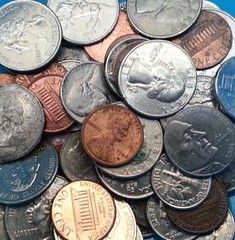 The most amusing version (to me at, least) was this one from Eric's hometown St. Louis Business Journal which got the story right but accompanies it with a stock photo of pocket change captioned, "A rare collection of coins sold for $23 million in a New York City auction."
The most amusing version (to me at, least) was this one from Eric's hometown St. Louis Business Journal which got the story right but accompanies it with a stock photo of pocket change captioned, "A rare collection of coins sold for $23 million in a New York City auction."
Below is an excerpt from a post-sale report by Legend Numismatics. -Editor
The recent Eric Newman auction was one of the most important auctions of past decade and we are here to discuss it. First we MUST thank Mr Eric Newman for allowing the numismatic world to share in ownership of these treasures. Its magnificent all the proceeds are going to charity. Thank you! Second, we say a "great job" to Heritage and Stuart Levine for all the work they did. Our only gripe: get a bigger auction room next time!
This sale not only had coins sell "beyond moon money" but had dozens of coin prices that were totally nuclear! We predicted it would be good old "shoot out" it was and then some. Its cool to watch bids just jump for $5,000.00 to $30,000.00 knowing there were several active bidders. The auction room was packed. The internet played hard. The buzz could not have been any stronger.
This auction certainly proved the rare coin market was MORE than alive and well. All through auction lot viewing we saw multiple major players we hadn't seen in a few years. They all said the same thing: this collection has incredible coins that are once in a lifetime opportunities. We fully agree. There was no question the dominant buyers in the sale were collectors. This should be expected. Only the sharpest and bravest of dealers tried to play for their own accounts.
To read the complete article, see: THE ERIC NEWMAN COLLECTION (www.legendcoin.com/cgi-bin/inventory/cms2.pl?page=market_report)
CONGRESSIONAL GOLD MEDALS FOR NATIVE AMERICAN CODE TALKERS
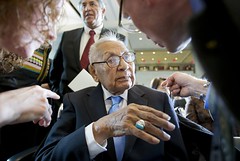 During the dark, early days of World War II, American military commanders were desperate for a code that could not be cracked by the Japanese.
During the dark, early days of World War II, American military commanders were desperate for a code that could not be cracked by the Japanese.
The solution rested in the obscure languages spoken by Native American tribes, unfathomable to the Japanese. Native American code talkers, as they became known, were able to transmit messages quickly and securely, giving American forces a critical edge.
While the contributions of Navajo code talkers have been honored by Congress and featured in films, the role of dozens of other Native American tribes has been overlooked.
But on Wednesday, Congressional Gold Medals, the nation’s highest civilian honor, were awarded honoring the service of hundreds of overlooked code talkers from 33 tribes.
Native American calls and whoops of pride echoed through Emancipation Hall when tribal representatives, some wearing headdresses or other traditional clothing, received the medals in front of an audience of hundreds.
Few of the code talkers are still living, and only one was present for the ceremony.
Edmond Harjo, 96, a member of the Seminole Nation of Oklahoma, served as a radio man with the 195th Field Artillery Battalion in France. Harjo, who attended in a wheelchair and received an ovation from the audience, said afterward that the honor was appreciated but belated.
To read the complete article, see: More Native American groups honored for their role as wartime code talkers (www.washingtonpost.com/politics/2013/11/20/c9d319ea-521d-11e3-9fe0-fd2ca728e67c_story.html)
Navajo Code Talkers were previously honored with a Congressional Gold Medal authorized by an Act of Congress passed in 2000. Under the Code Talkers Recognition Act of 2008 (Public Law 110-420), other tribes with members who served as Code Talkers during a foreign conflict in which the United States was involved were to be similarly honored. The Department of Defense identified an additional 33 eligible tribes for which the United States Mint was authorized to prepare and strike a gold medal with a unique design.
The Act further further authorized the Mint to strike silver duplicate medals that will be awarded to the Code Talkers, their family, or personal representative. Bronze medals are also authorized to be produced for sale to the public.
Images and descriptions of the 25 medals prepared and struck by the Mint so far are shown below. The line art design for a 26th medal which has not yet been struck is also included. The US Mint has offered for sale to the public 3-inch medals priced at $39.95 each and 1.5-inch medals priced at $6.95 each. The medals can be found online at www.usmint.gov/catalog
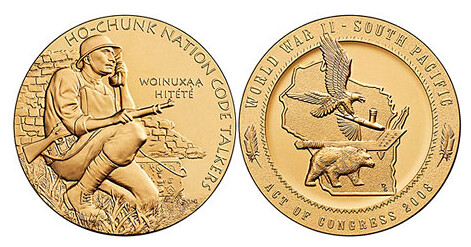
Ho-Chunk Nation medal
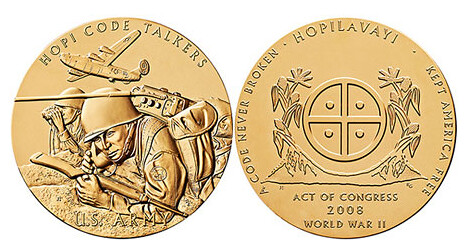
Hopi Tribe medal
To read the complete article, see: Native American Code Talkers Congressional Gold Medals (news.coinupdate.com/native-american-code-talkers-congressional-gold-medals-3038/)
EMPLOYMENT OPPORTUNITY!
Live and Work in Southern CaliforniaStack’s Bowers Galleries offers an important employment opportunity for the right person. We are seeking an experienced numismatist in the American series—coins, tokens, medals, and paper money—to work with our “dream team” of catalogers, building on the tradition of the Ford, Eliasberg, Bass, Cardinal, Norweb, Battle Born and other great collections.
If you can write in an authoritative and compelling manner with a high degree of accuracy, this may be just right for you! You will be working in Irvine, a modern community in dynamic Orange County, California—one of the finest areas to live. We offer generous benefits including medical and dental coverage, 401K plan, and more. Our offices are in our own modern, state-of-the art building with all amenities.
If you would like to be considered for this position please contact Q. David Bowers by mail or by email with your resumé, samples of your past writing (on numismatics or other subjects), and salary requirements: Mail to the attention of Q. David Bowers, PO Box 1804, Wolfeboro, NH 03894. Email to: Ckarstedt@stacksbowers.com
ANA MUSEUM RECEIVES DONATION OF GERRY HANSEN COINS
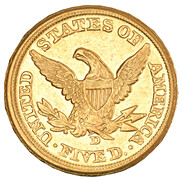 Money Museum receives large donation of gold, silver coins
Money Museum receives large donation of gold, silver coins
Collection of U.S. gold and silver coins was donated by the estate of Gerry Hansen
A donation of United States gold coins and Morgan silver dollars from the estate of Gerry Frederick Hansen will significantly enhance the collection held by the American Numismatic Association’s Edward C. Rochette Money Museum.
The gold coin donations include 29 Double Eagles from 1900 to 1927; 24 Half Eagles dating from 1842 to 1926; two $3 gold coins from 1854 and 1874; and four Quarter Eagles from 1852 to 1928. Of the 24 Half Eagles, 13 were minted at the long-defunct United States Mint branches in Charlotte, N.C., and Dahlonega, Ga.
“The Hansen gold coins, especially those from the Dahlonega and Charlotte mints, will greatly enhance our ability to tell the story of the U.S. Mint and the various branches it has operated across the nation, especially the two key southeast branches that operated in the 19th century before the Civil War,” explained Douglas Mudd, Money Museum curator.
Of the silver coins donated, 57 are Morgan silver dollars and include an 1889 Carson City coin graded AU55 by NGC and an 1893 San Francisco graded XF by PCGS.
“The Morgan dollars will enable us to expand the collection used for Summer Seminar classes and increase the number of Morgan varieties that we have available for education,” Mudd said.
The ANA will exhibit the gold coins from the Dahlonega and Charlotte mints as part of the Museum Showcase at the 2014 National Money Show, to be held in Atlanta, Ga., Feb. 27 to March 1, 2014, at the Cobb Galleria Centre.
“Donations such as this are the bread-and-butter that has allowed the ANA to grow its collection over the years into the world-class collection it is today,” Mudd said. “This improves our ability to fulfill our educational mission.”
Collectors interested in donating numismatic artifacts to the Money Museum are encouraged to contact museum staff at 719-482-9834 or email museum@money.org.
STANLEY GIBBONS GROUP ACQUIRES NOBLE INVESTMENTS
Caroline writes:
I wanted all of our Numismatic friends to receive the exciting news about acquisition of Baldwin’s from me personally. It is a great opportunity for us to thank you for your support over the years, which I very much hope will continue.
I have included below the press release issued by The Stanley Gibbons Group plc yesterday about the acquisition.
As far as Baldwin’s is concerned it is very much ‘Business as Usual’ and we’re looking forward to our Islamic auction in December, and two great sales in New York in January!
The Stanley Gibbons Group Acquires Noble Investments
 British rare stamp and collectibles merchant, The Stanley Gibbons Group plc, has successfully completed its acquisition of Noble Investments (UK) PLC today; putting it in the top 100 of London’s AIM listed companies with a market value in excess of £130m.
British rare stamp and collectibles merchant, The Stanley Gibbons Group plc, has successfully completed its acquisition of Noble Investments (UK) PLC today; putting it in the top 100 of London’s AIM listed companies with a market value in excess of £130m.
The acquisition brings together four heritage brands which, when combined, sees the group become a leading global collectibles auction brand, dwarfed only by Sotheby’s and Christie’s by virtue of their handling of fine art sales.
Noble Investments, comprising: Baldwin’s- the globally respected brand in coins, established in 1872; Dreweatts- an auctioneer of antiques and collectibles such as watches, fine wine and jewellery, established in 1759 and Bloomsbury- a leading UK auctioneer of books, manuscripts and art, join The Stanley Gibbons Group plc- itself established in 1856 and holders of the Royal Warrant as philatelists since 1914.
With over 250 staff and offices in the UK, Hong Kong, Singapore, US and the Channel Islands, the company aims to deliver a truly global service by bringing the world’s collecting community into one place.
“Our online development plans to create a global online hub for buying and selling collectibles will be enhanced by the wider range in which we now have authority and expertise.” said Mike Hall, CEO of the Stanley Gibbons Group.
“This acquisition means that sellers can expect to achieve the best realisation possible by virtue of our international reach, the size of our combined databases and superior specialist expertise; whilst buyers can be assured by the Stanley Gibbons guarantee of authenticity and standards of service.”
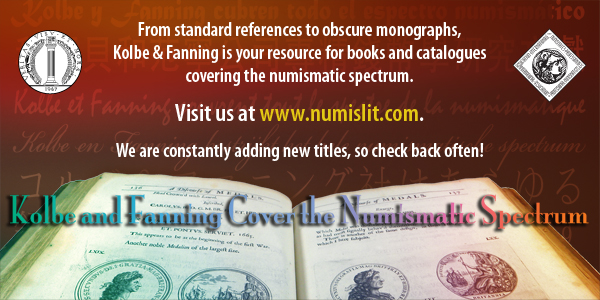
HARVEY STACK ON THE MILTON HOLMES COLLECTION
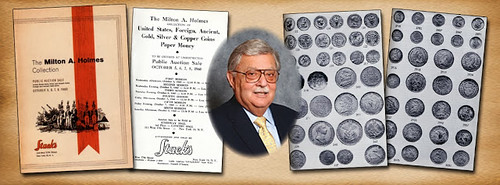
As we review many catalogs received each year we see the term "old time collection” used and are often asked, "What is that?"
In general, the phrase, “old time” refers to a collection formed over a period of 30 to 40 years, held by a single collector or his family.
I could list scores of names of collectors who formed “old time” collections during this period. However, I would like to use a collection that Stack's sold in 1960 as an example. It was formed by Milton A. Holmes, an industrialist who had the extra wealth to acquire items to enhance his collection, which he started some four decades before his death in 1960.
Examining the collection formed by Milton A. Holmes leads one to believe that there must have been relatively few who were interested in general coin collecting at the time. For Proof coins struck from 1858 to 1915 (when the mint temporarily ceased making Proof coins), the number struck each year was basically 1,000 or fewer in silver and gold, and somewhat more in copper and nickel. There were always some left in the Mint's vault, and in the late 19th century one could still buy earlier issues. So, it is evident that those who collected were a small number. Milton A. Holmes was able to acquire many of his coins at close to metal value. He always talked of "collector's luck" when he was successful in acquiring, either from private sale or an early auction, a specimen he had sought for a period of time.
During the early 20th century there weren’t many places to get coins for collections. Few dealers existed, mostly in larger cities and hardly any pricelists were available. Only a few dealers conducted auction sales, as they often bought collections outright and sold the pieces to their clients. The pickings therefore were slim even though more coins were around. In the Holmes Collection there was an occasional coin acquired from early auctions conducted by the Chapman brothers, Tom Elder, B. Max Mehl, and MacAlister and a bit later from Wayte Raymond and the Stack brothers.
There were few sources of information circulating during the early 20th century. There was The Numismatist (the official magazine of the American Numismatic Association), the Coin Collector Journal, and a few textbooks. So again, the hunt to find items of interest and information was not easy. On occasion a collector had the opportunity to buy from a contemporary collector some or all of a collection, but that was rare. Again Mr. Holmes would call such a situation 'collector's luck.'
To illustrate the growth of coin collecting at this time, the American Numismatic Association, which had first started with a few hundred collectors grew to nearly 1,000 by the early 20th century. Still conventions were scarce and communication between numismatists could be difficult. Mr. Holmes had to take his time in finding items and building his collection; thus a collection such as his could take decades to assemble. It took dedication to try to complete a series or even to get examples from the Philadelphia or branch mints. This dedication is what, in my mind, sets apart these "old time" collections and makes them so important.
To read the complete article, see: Remember When: Old Time Collections Part 1 (stacksbowers.com/Blogs/remember-when-old-time-collections-part.html)
CUHAJ ATTENDS XII INTERNATIONAL SYMPOSIUM OF MEDALS
Every two years selected artists gather in Kremnica, Slovakia for a month of medal making. Currently under the sponsorship of the National Bank of Slovakia, the five artists selected for the 2013 event included: Hugo Maciel , 24, from Portugal, George Cuhaj, 53, of the USA, Vladimir Durbak, 60, of Slovakia, Miroslav Kovarik, 62, of the Czech Republic, and Laszlo Zagyva, 69, from Hungary. This brings to 60 the number of artist participating in the program since 1988.
The program is to create obverse and reverse plaster models for a struck medal (to be produced at the Kremnica Mint, the state mint of Slovakia), and plaster designs for five additional sand cast medals. The artists pay for travel and food, the housing and studio is in the Angyel house, the National Bank's house in Kremnica. (The Angyel family of the 1800s were a father-son team of painter and sculptor.) One of each struck and cast medal is retained in the permanent collection of the Kremnica Museum, and the artist receives one of each cast medal, five of the struck medals of their design plus one struck medal of each of the other artists, and a 600 euro stipend (about 825 US dollars).
Kremnica is a town dating back before 1000 AD, and was granted minting privileges in 1328. It is nestled in two steep sloped valleys forming a T-shape, with the historic center at the top of the "T". Gold, Silver and Copper were mined actively in nearly hills and towns from the 1250s thru 1993.
The Museum staff was most helpful is making us feel welcome, as were the resident artist in the town who stopped in for visits, sharing meals or invitations to their home studios.
There were two arranged tours, one to the National Mine Museum in the town of Banska Stiavnica, and the second to the historic mountain village and the Spes Cathedral of St. Martin, with a view of the Spes Castle in the distance. The historic mountain village was called Vokolinec Ruzomberok and is a UNESCO heritage site.
The first eight days were very busy getting the clay designs finished and made into plaster models ready for delivery to the Mint. The next ten days were a bit more relaxed, in making the plaster models for the cast medals, and with a visit to each of the two sand cast foundries used to realize our project. Then there was about a week of waiting, when visits and tours were arranged, or more projects were worked on.
In this case, Mirek Kovarik brought his personal forge and made some lost wax molds and did a bronze pour in that time. Finally, the works were delivered very near to the day of the opening of the exhibit. The exhibit consisted of one of each medal by each of the participating artists in the 2013 symposium. The display is open during regular museum hours until February 1, after which one medal of each artist remains on display in the permanent display of the symposium, and the remaining medals are retained in the museum collection.

The Kremnica mint was founded in 1328, parts of this building were from the 1600s. The medals pressroom in the photo has belt driven presses dating from 1920 (As Hungary took all the machinery after WWI to update the Budapest Mint). They have a modern coining area built in a recently enclosed former courtyard.
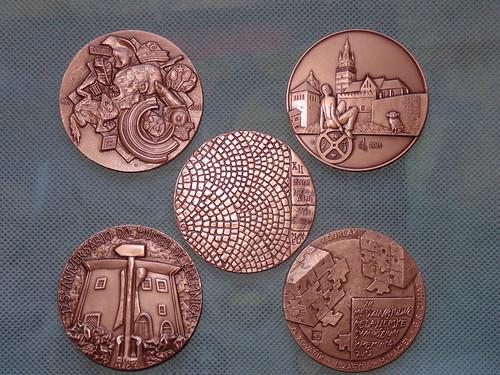
Part of the project was to prepare plaster models for a struck medal, the second part of the project was to design five cast medals. This is one side of the struck medals, minted at the Kremnica Mint.
They had 2013 coin sets for sale. Unc set, at 22 euro, a Proof-like set at 32 euro and a deluxe proof set in a wooden box for 82 euro
THE BOOK BAZARRE
BRINKS CHARGED WITH PENNY SWITCHEROO
A penny-meltdown moneymaking plan is at the heart of a federal lawsuit that pits the Brinks Co. against its former internal auditor.
Brian D. Holbrook, the auditor, charges in his whistleblower lawsuit that Brinks defrauded the United States by allowing a Jackson County metallurgist to sort through pennies that Brinks kept for the Federal Reserve, take the coins that contained more copper, and replace them with those that had less.
The lawsuit, filed two years ago in New Jersey against Brinks, Jackson Metals and metallurgist Walter Luhrman, was moved recently to U.S. District Court in Columbus at the request of the defendants.
Although most of those involved in the lawsuit would not discuss the case on the record, court documents give details.
Holbrook’s complaint says that Luhrman, of Jackson, had an agreement with Brinks that allowed him to cull pennies minted in 1982 and earlier from coin piles that Brinks kept for the Federal Reserve in 2006 and 2007. Luhrman melted the pre-1983 pennies, which were minted with 95 percent copper and 5 percent zinc, to extract the copper, the complaint says. He replaced those pennies with newer ones, which are 2.5 percent copper and 97.5 percent zinc.
In the lawsuit, Holbrook, of Parma Heights in Cuyahoga County, estimated that Luhrman received $44,892 for each tractor-trailer of pennies he obtained from Brinks. A total was not listed in the documents.
Luhrman profited, the complaint says, because the copper in each penny was worth about 2 cents. Brinks saved money because Luhrman’s company, Jackson Metals, moved the pennies from Brinks’ customers with an excess of the coins to places with a shortage, cutting transportation costs for Brinks, according to the complaint.
In its answer to the court, Brinks does not say whether the allegation of penny-switching is true.
To read the complete article, see: Ex-auditor’s lawsuit alleges Brinks’ coin-culling deal was fraud (www.dispatch.com/content/stories/local/2013/11/18/ex-auditors-lawsuit-alleges-brinks-coin-culling-deal-was-fraud.html)
METAL DETECTORIST UNCOVERS RARE GOLD COIN OF EMPEROR LICINIUS I

A RARE Roman gold coin worth up to £30,000 was initially mistaken for a sweet wrapper by a metal detecting enthusiast in south Wiltshire.
The 1,700-year-old gold one-and-a-half solidus is one of four known examples from the reign of Emperor Licinius I.
The finder, who has asked remain anonymous, unearthed the artefact after an otherwise fruitless day out with his metal detector.
He arrived late at a meeting place to find the group he was planning to join had already left, and he didn’t have a signal on his mobile phone.
“Heading home, I remembered another site which had not produced many finds for me but rather than waste the day I decided to head there,” he said.
It began to rain which made it hard to read the screen on the detector and turned the field into mud, making it difficult to walk.
“I had not had a single signal for about 15 minutes when I got a slight response - one that any detectorist will tell you is not worth digging,” he said.
“However, having had so very few signals for a while, I decided to dig it up. Six inches down I dug out a clod of earth and sticking out of the side was the unmistakeable glint of gold.
"Having dug up lots of sweet wrappers up over the years, I thought it was the foil from a packet of Rolos but on pulling it out of the mud I saw it was a coin.”
Dix Noonan Webb, the international coins and medals specialists, are expecting the coin to sell for up to £30,000 when it goes under the hammer in London on December 5.
Christopher Webb, head of the coins department at Dix Noonan Webb, said: “This is an incredibly exciting discovery which was made in the most unpromising circumstances. The three other known examples of this type are all in some of Britain’s most famous museum collections.”
To read the complete article, see: 'Rolo wrapper' turns out to be Roman coin worth £30,000 (www.salisburyjournal.co.uk/news/10825955._/)
1881 NETHERLANDS GOLD LIFESAVING MEDAL
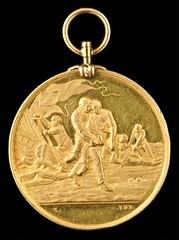 A RARE medal awarded to a lifeboat skipper after a heroic mercy mission more than 130 years ago is going under the hammer at auction.
A RARE medal awarded to a lifeboat skipper after a heroic mercy mission more than 130 years ago is going under the hammer at auction.
The lifeboat went to the aid of a stricken Dutch steamship in horrendous weather.
The 438-ton Ingerid was sailing from Norway to Naples with a cargo of fish on January 17, 1881, when she struck the Sunk Sand, off Clacton.
The captain and six remaining crewmen were forced to lash themselves to the mast in the bitter cold.
The wreck was finally reported by the Cork Lightship three days later and the Harwich lifeboat, Springwell, was launched at 7pm. But the cold was so severe, it had to cut through ice to reach the mouth of the harbour.
The lifeboat crew rowed courageously through stormy seas for eight hours to reach the Ingerid before dawn.
The crew – led by Captain A St Vincent Nepean and assistant coxswain William Britton – boarded the ship and helped the survivors into the lifeboat before setting off on the gruelling return journey.
Nepean and Britton were awarded gold life-saving medals by the Netherlands and silver medals by the RNLI. Their 11-strong lifeboat crew received silver Dutch medals.
To read the complete article, see: Hero lifeboat skipper's medal to be auctioned (www.gazette-news.co.uk/news/local/10819389.Hero_lifeboat_skipper_s_medal_to_be_auctioned/)
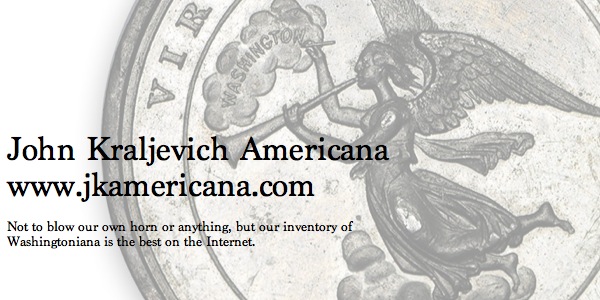
THE PRAGER WINERY MONEY ROOM
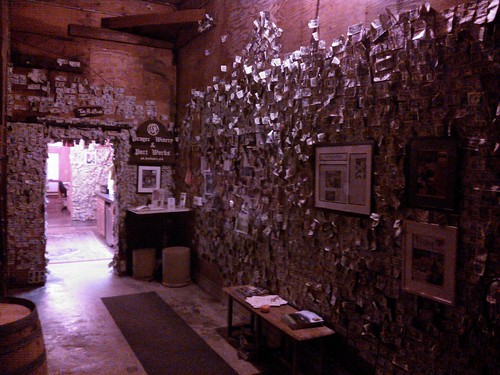
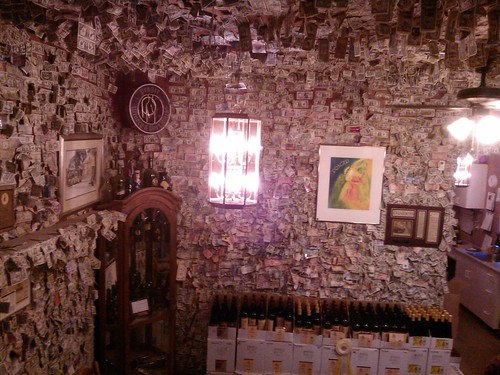
For more information about the Prager Winery, see: Prager Winery & Port Works (www.pragerport.com)
FAKE MILLION YEN BANKNOTE FOOLS CLERKS IN JAPAN
Staff in a grocery shop in the north of Japan have apparently been taken in by a sticky Post-It-style note in the shape of a million yen bill, it's reported.
The fact that the largest Japanese banknote is 10,000 yen (£62) was lost on the cashiers. Nor did they notice that Yukichi Fukuzawa - the influential Japanese writer whose face adorns the country's currency - sports a "wry smile" on the single-sided fake bill, the Mainichi Daily News reports.
Local police say they are investigating a possible forgery case. But this is not the work of a master forger. The note's provenance is rather more straightforward - it's a novelty item produced by a company based near Osaka that stopped making the fake money stickers in October 2012 after several were passed off as real currency.
After the latest incident, the company has decided to stop selling its remaining stocks of the comedy banknotes. It is illegal under the Control of Imitation of Currency and Securities Act to manufacture products that "could be mistaken for genuine bills and coinage", the paper says.
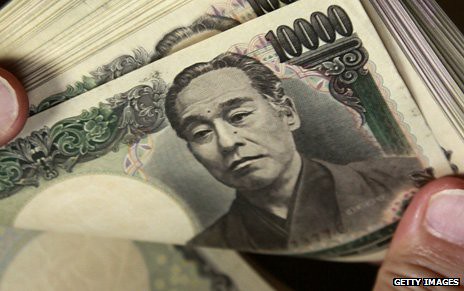
Genuine 10,000 yen notes
To read the complete article, see: Japan: Shop fooled by spoof million yen banknote (www.bbc.co.uk/news/blogs-news-from-elsewhere-25001421)
ANOTHER GOLD BARS IN AIRPLANE TOILET STORY
A stash of 24 gold bars worth more than $1.1m has been discovered in the toilet compartment of a commercial plane in eastern India.
Cleaners found the haul in two bags on board a Jet Airways flight at Kolkata airport, officials said.
India is one of the world's main gold consumers and imports are seen as a major contributor to the country's account deficit.
It recently raised duty on imports of gold jewellery to 15% from 10%.
It was the third increase this year as the government attempts to curb demand for the precious metal, which many Indians traditionally hoard in the belief it will bring financial security.
The cleaning staff of the airport were going though their routine duties and found two bags in the toilets of the plane," airport director BP Mishra told AFP news agency.
The gold has been valued at between 70m and 90m rupees (up to $1.4m or £890,000).
To read the complete article, see: Gold bars worth $1.1m found in plane toilet in India (www.bbc.co.uk/news/world-asia-25013393)
To read the earlier E-Sylum article, see: CLEANERS DISCOVER 280 GOLD BARS IN AIRPLANE TOILET (www.coinbooks.org/esylum_v16n44a30.html)
FEATURED WEB SITE: COINING TECHNOLOGY HERITAGE PROJECT
This week's Featured Web Site is suggested by Bruce W. Smith, who writes:I found a site that may be of interest to our readers: The Coining Technology Heritage Project. This project cover the first three centuries of coining presses.
From the site:
Our aim is to locate and document minting machines, tools and processes of the 16, 17 and 18th centuries. Findings show that these artifacts are often hidden away in storage rooms and known only by museum staff. Our team, based in Mannheim, welcomes all information and possible leads to helping find and document these machines and tools in museums or private collections around the world.
This is a unique project intended to document the mechanical, in series production of coinage beginning in the mid 16th century, two hundred years before the start of the Industrial Revolution. It is based on international cooperation with the goal of discovering and promoting knowledge of a specific and little known aspect of our common Technological and Industrial Heritage.
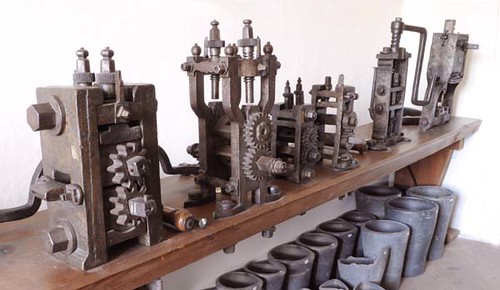
www.segoviamint.org/cth.htm

